Biocontrol Agents
Insect pathogenic nematodes
Description
- Nematodes are microscopic roundworms. The species used in greenhouses are <1 mm in length (figure 1). Although they are visible with the naked eye, especially when in a water droplet placed on a dark background, they are more easily seen with a good hand lens or under a microscope.
- Hosts infected by nematodes take on a brown mushy appearance as they are actually killed by symbiotic bacteria that live inside the nematode. Young nematodes may be seen moving inside the host especially after nematode reproduction (figures 2 and 3).
-
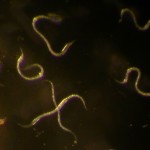
-
Figure 1
-
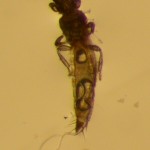
-
Figure 2
-
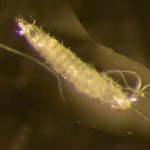
-
Figure 3
Biology
- Nematodes are sold as “Infective Juveniles” (IJs), the developmental stage that can infect new hosts.
- Nematodes move through the water film in soil (or on the leaf); consequently the substrate must be moist prior to application to allow them to search for an insect host.
- Nematodes such as S. feltiae locate insects by detecting their waste products, especially CO2.Others rely on an “ambushing” method, lying in wait for insects to move within range.
- When nematodes have located a host, they enter through natural body openings such as the anus, mouth or spiracles (openings in the insect’s body for breathing). Inside the insect, they release the symbiotic bacteria they carry with them. When the insect dies from the bacterial infection, its body breaks down, creating an ideal environment for the nematodes to feed and reproduce.
- Death from nematode infection usually takes approximately 2-3 days.
- The life cycle includes an egg, four immature stages (the third of which is the IJ) and the adult. The IJ is the only free-living stage (i.e. it does not need a host insect). It is mobile and can survive for several weeks without feeding if conditions are favourable. The life cycle from egg to adult takes 10 days (at 28oC) to 20 days (at 18oC).
- When external conditions are suitable, the IJs leave the dead insect and enter the environment in search of new hosts. While nematodes have the potential to ‘re-cycle’ and become established within an insect population, this does not normally occur at a high or fast enough rate in the greenhouse, so repeat applications are needed to control pest populations.
Recommendations for Use
Packaging and storage
- Nematodes are mass-produced in fermentation tanks or insect hosts and packaged in quantities of 5 million – 1.25 billion.
- Products are often sold with the nematodes in a gel or clay-based formulation, or on an inert carrier such as a sponge (figure 4).
- Product should be stored at 5oC if not being used immediately – do not freeze.
- Refer to the Grower Guide: quality assurance of biocontrol products to determine the quality of the nematodes at receipt at the greenhouse.
Application techniques
- Remove all fine filters from the spray lines (1 mm, 50 mesh or finer)
- Partly fill the spray tank with cool, clean water (10-15°C), turn on the agitator (allow to run until spraying is complete; agitation is required to keep the nematodes in suspension).
- Add the nematodes to a bucket containing 10-12 litres clean, cool water and stir gently; if on a sponge, gently squeeze into the water to release the nematodes into suspension; if a ‘gel’, gently agitate to disperse the product and leave for ca. 5 minutes to allow the nematodes to rehydrate.
- Gently stir the pre-mix suspension before transferring to the spray tank, fill sprayer to the required final spray volume.
- Use spray mixture immediately after mixing, agitating throughout the application to keep the nematodes in suspension.
- For control of fungus gnats and thrips, apply to the growing medium; plants should be lightly watered prior to and after application. For leafminer, apply to the plant foliage using a wetting agent to improve coverage. See http://www.beckerunderwood.com/library/NematodeChemicalCompatibility_US.pdf for compatibility of wetting agents with nematodes.
- Keep spray pressure below 300 psi.
- Nematodes can also be applied through overhead, hand held or through drip irrigation, but caution is needed when using drip irrigation to prevent nematodes settling in the lines, and to ensure that viable nematodes are delivered in high enough numbers along the full length of the drip line.
Introduction rates
- There are a number of suppliers of nematodes; however, their recommended application rates and treatment intervals often vary.
- For control of fungus gnats, rates vary from 500,000 – 1,000,000/m2 with an application interval of 1-6 weeks and up to several consecutive applications, depending on initial infestation levels of the pest. Generally, if fungus gnats are the only target of the nematodes, fewer applications are needed than if thrips are also being treated. If thrips are the focus, then rates for thrips will also provide control of fungus gnats.
- For control of thrips, some suppliers recommend foliar treatments (125,000-250,000/m2 applied 1-2x/week) to provide control of adult and larval thrips. However, most research suggests that thrips are most effectively infected in the pupal stages which most commonly reside in the soil.
- In Ontario, Canada, many growers use nematodes as part of their thrips control program. The most commonly used rate is 500,000/m2/week; applied at low spray pressure, with applications targeting the top of the soil. Typically with this kind of application some nematodes will end up on foliage as well.
- In the early stage of plant growth, the foliage is sparser and sprays will easily penetrate to reach the soil. As the plants grow and the canopy becomes more dense, more nematode are intercepted by the foliage and fewer nematodes reach the soil, with resulting decrease in efficacy. At this point many growers rely on different biocontrol agents for thrips control.
- For leafminer, nematodes provide control by penetrating the leaf mine and, infecting the larvae within (figure 5). Research with carpocapsae and S. feltiae demonstrated the potential of both species for leafminer control. Efficacy assessments in commercial greenhouses in Ontario showed a 70-80% reduction of leafminer populations using nematodes.
- There is little in the way of specific recommendations for leafminer from the suppliers, although the leafminer activity is noted.
- Foliar applications for leafminer must take into account the environmental constraints that can affect nematodes as listed below.
- Ontario growers apply approximately 125,000-250,000 nematodes/m2. Nematodes are usually used for leafminer control because registered pesticides are not effective. It is recommended that they be applied 2x/week.
- For foliar applications, apply in the evening, preferably with shade curtains drawn so that foliage remains wet for at least 2 hours. Use of a wetting agent will improve coverage. Coverage of the upper leaf surface is adequate for leafminer control.
Environmental considerations
- Nematodes are very susceptible to UV light and should not be applied in direct sunlight.
- They are also susceptible to desiccation, and should be applied to moist (but not wet) soils.
- Media temperature should be between 10-30oC (this range varies by a few degrees with different suppliers).
- Nematodes are compatible with many pesticides used for control of fungus gnats, shore flies, thrips etc. http://www.beckerunderwood.com/library/NematodeChemicalCompatibility_US.pdf.
Monitoring
- It is difficult to monitor effectiveness of nematodes for control of fungus gnats or thrips, other than indirectly, i.e. by monitoring the pest populations. For leafminer, it is possible to check mortality of larvae dissected from leaf mines.
Crop Considerations
- Nematodes are probably used more widely in ornamentals than vegetables. Exposed growing media in potted plants and soil-grown cut flowers, provides greater opportunities to target fungus gnats and thrips. The susceptibility of crops such as chrysanthemum and gerbera to leafminer also results in additional usage in ornamental crops.
-
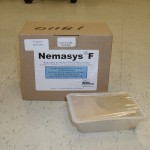
-
Figure 4
-
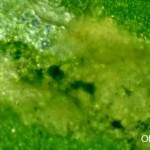
-
Figure 5
References
- Osborne, L.S., Bolckmans, K., Landa, Z. and Peña, J. 2004. Kinds of natural enemies. In Biocontrol in Protected Culture, eds: K.M. Heinz, R.G. Van Driesche and M.P. Parrella, Ball Publishing, Batavia, Illinois,
- Wardlow, L.R., Piggot, S. and Goldsworthy, R. 2001. Foliar application of Steinernema feltiae for the control of flower thrips. Mededelingen Faculteit Landbouwwetenschappen, Rijksuniversiteit Gent, 66(2a): 285-291.
- Buitenhuis, R. and Shipp, L. 2005. Efficacy of entomopathogenic nematode Steinernema feltiae (Rhabditida: Steinernematidae) as influenced by Frankliniella occidentalis Thysanoptera: Thripidae) developmental stage and host plant stage. Journal of economic Entomology, 98(5): 1480-1485.
- Bennison, J., Maulden, K. and Tomiczek, M. 2005. Update on the use of entomopathogenic nematodes against WFT in the UK. Sting, 27: 7-9.
- Ebssa, L., Borgermeister, C., Berndt, O. and Poehling, H.-M. 2001. Efficacy of entomopathogenic nematodes against soil-dwelling life stages of western flower thrips, Frankliniella occidentalis (Thysanoptera: Thripidae). Journal of Invertebrate Pathology, 78: 119-127
- Olthof, T.H.A. and Broadbent, A.B. 1992. Evaluation of Steinernematid nematodes for control of a leafminer, Liriomyza trifolii in greenhouse chrysanthemums. Journal of Nematology, 24: 612
- Sher, R.B., Parrella, M.P. and Kaya, H.K. 2000. Biological control of the leafminer Liriomyza trifolii (Burgess): implications for intraguild predation between Diglyphus begini Ashmead and Steinernema carpocapsae (Weiser). Biological Control, 17: 155-163
- Williams, E.C. and Walters, K.F.A. 1994. Nematode control of leafminers: efficacy temperature and timing. Proc. Brighton Crop Protection Conf., Pests and Diseases, 3: 1079-1084
Further Reading
- Heinz, K.M., R.G. Van Driesche and M.P. Parrella 2004. Biocontrol in Protected Culture, Ball Publishing, Batavia, Illinois
- Malais M.H and Ravensberg W.J. 2003. Knowing and Recognizing: The biology of glasshouse pests and their natural enemies. Koppert BV, Berkel en Rodenrijs, The Netherlands and Reed Business Information, Doetinchem, The Netherlands.





